
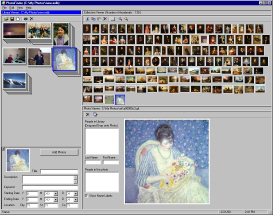
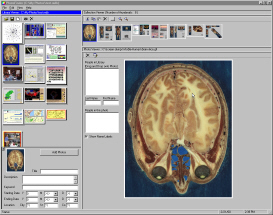
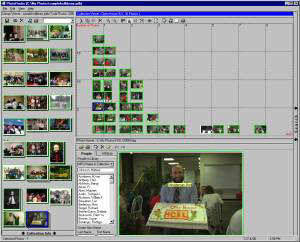
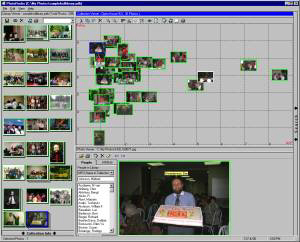
 |
 |
 |
 |
 |
Some of the efforts in this project include innovative ways of addressing such tasks as different ways input, cataloging image metadata, searching and browsing for images. We have started with a collection of test beds and a number of image browsing/editing/searching tools.
We held a day-long workshop on 'Personal
Photo Libraries: Innovative Designs' on June 1, 2000 with participants from
Intel, Kodak, Microsoft, MERL, MIT, and others.
The University of Maryland Human Computer Interaction
Laboratory has developed the PhotoFinder prototypes, as part of its research
effort on Personal Photo Libraries. We appreciate the major support of Intel
Corporation and contributions from Microsoft and IBM.
Our goal was to develop an understanding of user needs, appropriate tasks, and
innovative designs for consumer users of digital photos. As digital cameras,
scans of existing photos, PhotoCDs, and photos by email become more common,
users will have to manage hundreds and then thousands of photos. Their goals are
to be to view, explore, locate, reorganize, and then use photos of interest.
PhotoFinder 1.0 (March 2000) was our first prototype. It supports visual
browsing only for a library containing 1-10 collections which contain 1-100
photos. If offers a novel technique known as direct annotation to enable
personal names to be placed on a photo.
PhotoFinder 2.0 was completed during summer 2000 and the version 2.2 at the end
of 2000. It supports larger libraries, offers search capabilities by person,
date, location, and description, allows collection combinations, provides richer
collection thumbnail manipulations, and other features.
PhotoFinder 3.01 is now available (June 2001). It includes following features
and more.
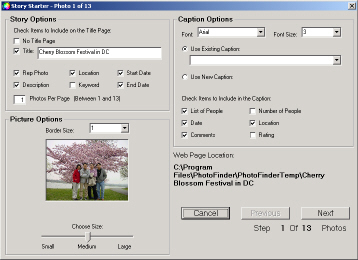 |
A new feature, called StoryStarter, has been included with PhotoFinder 3.0. StoryStarter allows users to take a collection of photos that have already been annotated and publish web pages using any of the information stored in PhotoFinder. The web pages are meant to be a starting point for sharing stories with family and friends using digital pictures. The HTML pages generated by StoryStarter are easy to edit with any HTML editor and can be uploaded to any web directory. Click here to see a story made with the help of StoryStarter http://www.cs.umd.edu/hcil/photolib/Florida2000. |
Our research was enhanced by student projects such as:
For CHI 2001 (April 3-5, Seattle) we showed 3300 photos from
65 events on a network of 7 machines. People were very enthusiastic,
making comments like "Great! Thanks for the memories!" and "This
is addictive." CHI pioneers and newcomers spent hours browsing and
annotating, returning to bring their friends. Visitors added 1000 name
annotations plus 400 captions, and attendees brought us 1200 new photos.
Our visual history of CHI and related conferences is available from the ACM SIGCHI website (http://www.sigchi.org/photohistory).
Our papers describing the process and interface design issues include:
A photo history of SIGCHI: evolution of design from personal to public
ACM Interactions 9, 3 (May 2002), 17-23.
Immediate usability: a case study of public access design for a community photo library
Interacting with Computers 16, 6 (2004), 1171-1193.
|
|
|
|
|
|
Technical Description (PhotoFinder Kiosk 1.0)
PhotoFinder Kiosk was built atop a client/server architecture. PhotoFinder server is designed to receive all the requests from the clients directly, process them, update Database, and broadcast updates to all the connected clients. The reason of inserting an additional PhotoFinder server layer instead of allowing direct communication between clients and MS SQL server is that all the connected clients need to be updated synchronously in real time whenever any changes is detected in database. PhotoFinder Kiosk has been implemented with Microsoft DCOM(Distributed Component Object Model) to enable the communication between the client and the server that are located at different machines. Each client has a local cache of necessary database tables for fast and efficient browsing and searching to reduce the load of PhotoFinder server.After collecting annotations and captions from CHI 2001 attendees, we developed PhotoFinder Web to build A Photo History of SIGCHI for the ACM. This site is a public archive for the SIGCHI community, for historians, and for interested surfers who just want to see the people who are working hard to create better interfaces and happier user experiences.
The three photo libraries in the Photo History of SIGCHI are:
PhotoFinder Web lets viewers browse libraries, conferences (collections) and individual pictures. Viewers can also search by name or search the names, captions and other metadata in the database. It optimizes the layout of thumbnails to the browser window size, and automatically adjusts when the user resizes a window. This differs from most web-based tools by helping to accommodate a wide range of screen sizes.
PhotoFinder Web is implemented using Java Server Pages (JSP), a mySQL database, and the Apache Tomcat server. The database used by Web Site Starter has the same schema as PhotoFinder.
The paper Web-siteStarter: Exporting photo library to the web evaluates several other web based photo libraries and describes PhotoFinder Web in detail.
The PhotoFinder project showed the importance of the use of semantics in managing the personal photo library and suggested ways to use semantics for searching and browsing. The PhotoFinder has been extended to the MediaFinder, which enables users to explore and manage common types of personal media data such as images, audio clips, voice mail, videos, web pages, and emails. Personal media data are difficult to explore and manage because the tools for users are inflexible and driven mostly by storage and distribution models, not user's mental models. A file system provides only a single-inheritance structure. Personal media items can only be in one place at a time, and so can occupy only one spot in the semantic structure.
MediaFinder project introduces Semantic Regions, an innovative way for users to construct mental models by drawing regions on 2D space and specifying the semantics for each region. Then users can apply personal ontologies to personal media data using the fling-and-flock metaphor. This allows photos (or other personal media) to be dragged to the display and automatically grouped according to time, geography, family trees, groups of friends, or other conceptual maps. The concept of Semantic Regions is based on a major hypothesis: Spatially organized information based on the semantics of personal media and the users� mental models for managing personal media will greatly improve task performance as well as user satisfaction.
MediaFinder is a prototype interactive tool built to investigate the use of Semantic Regions for personal media management and exploration. MediaFinder provides a working environment for Semantic Regions construction and operation. MediaFinder users can construct the mental models they need for their data and personal media management tasks such as organization, meaning extraction, search, navigation, indexing, and distribution. Without MediaFinder, such tasks would be difficult and time-consuming to achieve.
 |
A friend group mental model: Each region represents a person and contains all the photos annotated with the name defined in it. The regions are grouped into 5 clusters to represent different friend groups (UMD friends, high school friends, graduate school friends, college friends, and UMCP friends). Each group has its own color to represent the different group of friends. |
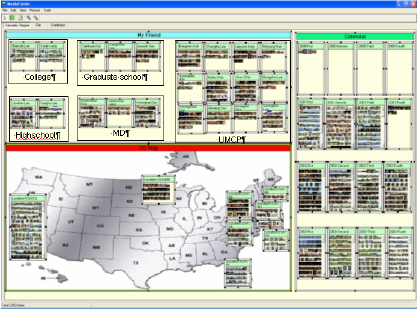 |
Three mental models, friend groups, quarter year calendar, and US map (clockwise from the top region) are combined together. The regions in the My Friend region are grouped into 5 clusters to represent different friends groups (high school friends, college friends, graduate school friends, UMD CS friends, and MD friends). Each region in the Calendar group represents a quarter year from 2000 to 2003. |
Papers on Semantic Regions and MediaFinder:
The PhotoFinder project is led by Ben Shneiderman, Catherine
Plaisant and Ben Bederson. Graduate student Hyunmo Kang has been the lead
programmer and produced the Visual Basic software and the User Manual, with help
from Manav Kher during 1999. Bill Kules was the project manager for
preparing our conference installations and developing PhotoFinder Web.
Undergraduates Todd Carlough, John Jung, Nabby Cheung built the sample data
collections and databases. Richesh Ruchir developed the Java Server Pages for
PhotoFinder Web. Support from other HCIL members and students is greatly
appreciated. Technical Description (PhotoFinder 3.02) Please read the licensing terms carefully and register first.
This will lead you to the download
area. See the HCIL PhotoMesa
project.
Faculty and Staff
Graduate Students
Undergraduate Students
Individual
Photos
Software/Download/Licensing
The executable (PhotoFinder runs on Windows 95/98/ME, Windows
NT/2000. PhotoFinder does not run on Apple Macintosh.) of PhotoFinder3.02
is available for download. (The size of the installation file is about 13MB.)
HCIL sample library is also downloadable separately. (The size of the sample
library file is about 25MB)
The user manual of
PhotoFinder2 is also available at http://www.cs.umd.edu/hcil/photolib/webPublications
A
photo history of SIGCHI: evolution of design from personal to public
ACM Interactions Volume
9,
Issue 3, pp
17-23
Immediate
Usability: A case study of public access design for a community photo library
Interacting with Computers, 16, 3, December 2004, 1171-1193
HCIL-2003-22, CS-TR-4481, UMIACS-TR-2003-50
Direct
Annotation: A Drag-and-Drop Strategy for Labeling Photos
Proc. International Conference Information Visualisation
(IV2000). London, England.
Visualization
Methods for Personal Photo Collections: Browsing and Searching in the
PhotoFinder
Proc. IEEE International Conference on Multimedia and Expo
(ICME2000), New York City, New York.
Videos
Downloadable MP4 (11 MB)
Bibliography
A listing of HCIL and other photolibrary-related
publications
Commercial Software
Commercial Web Sites
Here are some reviews on various image
browsing software packages.
Our Lab Tools
Sponsors and Partners
The Photo Library Project was initally supported by Intel
Corporation. Additional support came from Microsoft and IBM. ACM
SIGCHI supported the scanning of photos and Ricoh supplied cameras for our
CHI2001 installation.
Related Sites
Last updated Feb 1,
2004
�Copyright University of Maryland 2002, HCIL
PhotoLibrary Group